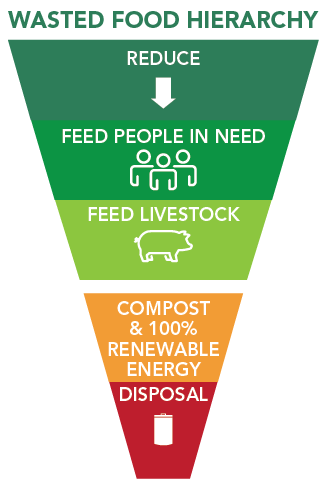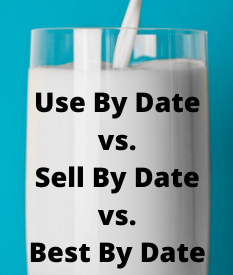Food Recovery Hierarchy
The below diagram displays how the handling of wasted food should be prioritized. This diagram should be kept in mind from the production, to purchase, cooking, and final disposal of any and all food products

Wasted food typically refers to food that was not used for its intended purpose and can fall into three subcategories: food waste, excess food, or food loss. All three types play a different role in the food recovery hierarchy.
Food Waste: plate waste, spoiled food, or cooking scraps
- Food under this category is typically reused at animal feed or is sent to be composted or anaerobically digested
Excess Food: food from restaurants or manufacturers that is recovered and donated to feed people
- This food helps those who utilize food banks, soup kitchens, or shelters
Food Loss: This is unused agricultural products such as unharvested or “ugly” crops
- There have been new entrepreneurial developments to open the market for “ugly” produce at a reduced cost to consumers.
The Importance of Food Waste Reduction
Lower your food budget. In the U.S the average family of four will spend $1500 annually on food that will go uneaten,.
Climate change. In the U.S. over 2% of the nation’s energy use is dedicated to the production and cooking of food that is never eaten, which is equivalent to 16 billion gallons of gasoline.
Boost food availability The Food and Agriculture Organization of the United Nations predicted that by eliminating food loss and wasted food we would have enough food to feed all the chronically undernourished (approximately 805 million people globally).
How Can I Reduce My Food Waste at Home?
Prepare a shopping list, sticking to this list and avoiding excess or unnecessary sales will save you time, money, and reduce food waste.
Buy in bulk if possible, this allows you to choose only the amount you need and place them in your own produce bags eliminating single use plastic packaging.
Freeze any leftover sliced vegetables, bread, or fruit for later.
Plan and prep meals. This will save you time throughout the week and make cooking nightly much easier.
The below resources are great for recipes to use up leftover food as well as information on how long food actually lasts:
Where Can I Donate Food?
If you are in the process of downsizing your pantry, making a move, or heading home from college please bring your non-perishables to one of the below organizations instead of throwing them away.
- CHOW
- Food Bank of the Southern Tier
- Loaves & Fishes
- Bear Necessities Food Pantry
- Catholic Charities of Broome County
If you are in need of food for yourself or your family you can visit these websites to find a food pantry nearest you or contact the Broome County Health Department for information about WIC.
Composting
Luckily in Broome County most of us have outdoor space, but even if you don’t, composting is still possible. There are a variety of composting methods for any size space either indoor or outdoor, and all times of year, the only limitation will be your understanding of the process and your enthusiasm.
If you are interested in composting in a backyard setting, please be aware you can pick up an Earth Machine Composter from the Broome County Landfill at any time for a price of $45 plus tax.
Please visit our Composting Page for more information regarding how you can start removing wasted food from the waste stream today!
Looking Toward the Future
In 2015 the USDA and EPA announced a domestic goal to reduce food loss and waste by half by the year 2030.
Legislation was recently passed in NYS in 2019 to manage organics waste from businesses. The legislation will officially go into effect on January 1, 2022 but Broome County officials are already working with local businesses and the NYS DEC to prepare for this change.
For More Information
EPA - Sustainable Management of Food

